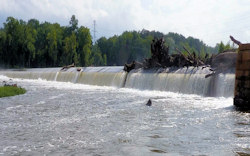

Virginia Department of Conservation and RecreationAn official website of the Commonwealth of Virginia Here's how you knowAn official websiteHere's how you know

Virginia Department of Conservation and RecreationAn official website of the Commonwealth of Virginia Here's how you knowAn official websiteHere's how you know
 Department of Conservation and Recreation
Department of Conservation and Recreation
Dams provide many valuable functions including support water supplies, irrigation, recreation, hydropower, fish and wildlife habitats, and flood reduction systems. When they fail, however, flooding can be catastrophic.
National Dam Safety Awareness Day promotes best practices in dam safety and reminds the public of steps to take to prevent catastrophic dam failures. The theme for National Dam Safety Awareness Day 2024 is, "Dam Safety is a shared responsibility. Know your risk, know your role, know the benefits of dams and take action."
Look out for these 5 signs that a dam might not be maintained and could be at risk of failure.


Low-head dams, also called “run-of-the-river” dams, are one of the greatest dangers to those who enjoy swimming, boating and floating on waterways. These dams run from bank-to-bank across a river or stream, creating a forceful “spin cycle” under the water’s surface that can trap even the strongest swimmer wearing a flotation device.
Whenever you are on the water, look for the following, which could indicate the presence of a low-head dam:
If you think you spot a low-head dam, it is crucial that you do these 3 things:
In cooperation with Virginia Department of Wildlife Resources, we urge everyone to stay safe by avoiding low-head dams while enjoying rivers and streams.
Find more safety tips at https://dwr.virginia.gov/boating/education/lowhead-dams/
Follow these additional tips for general safety around dams while recreating in or near the water:

To find out if you live in a dam breach inundation zone, contact the local emergency management agency or DCR’s Dam Safety Program staff.

